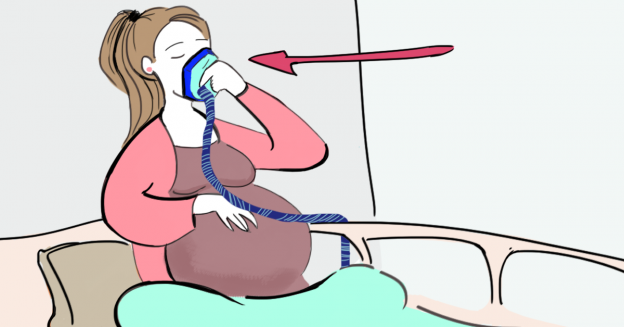Here's Why More Women Are Using Laughing Gas To Manage Labor Pains
You've probably heard of epidural and spinal block for labor pains — but laughing gas? Not so much. But there's a reason more and more women are turning to nitrous oxide, more commonly known as laughing gas, to mitigate the excrutiating pain that often comes with childbirth.
The Path To Pain-Free Childbirth
Childbirth is a beautiful experience for so many women, but that doesn't mean that it hurts any less. With labor often lasting for hours to even days, hospitals have tried to relieve the contraction pain through various methods. The laughing gas trend we're seeing is actually nothing new. It was a common treatment in the U.S. until about forty years ago, when the more potent epidural was introduced.
Laughing gas is still used extensively in other countries like Canada, Australia, and the U.K., where women use a mixture of 50% nitrous oxide and 50% oxygen to ease their labor pains. Despite its various benefits, laughing gas hasn't experienced a resurgence in America until only recently.

What Are The Benefits of Laughing Gas For Labor Pains?
In low quantities, nitrous oxide can be a very beneficial relief for both anxiety and pain. It reportedly "takes the edge" off the contractions and helps you to feel relaxed. Since it's not very potent, laughing gas won't get rid of the labor pain, but it will reduce your awareness of it.
Despite laughing gas' reputation for making people loopy, one woman reported that it actually helped her stay mentally present during childbirth. In an interview with Cosmopolitan, 32-year-old Lynnsey Robinson compares the birth of her two sons. With her firstborn, she remembers being distracted by the pain, while nitrous oxide during the birth of her second son allowed her to remain focused.
Some women might be worried that laughing gas might interfere with their body's natural functioning during and after childbirth. For instance, laughing gas won't have an effect on the release of oxytocin right after delivery that allows mother and child to bond.
Women might consider nitrous oxide as a treatment because it takes effect almost immediately. It's effects also wear off just as quickly, with just a few exales. Some might even find it empowering, as it's self-administered. You simply hold the mask to your face and control how much gas you want to inhale and when.
Why Shouldn't You Use Laughing Gas?
Nitrous oxide does have side effects, such as nausea, vomiting, and sedation. Women with vitamin B12 deficiency should also avoid using nitrous oxide as treatment. If you're currently expecting, you should still consult your doctor before delivery day.
Have you used laughing gas for labor pains? Comment to tell us about your experience!
Follow us on Facebook for more stories like this!
More steaming articles
 The "Perfect" Woman According To 18...
The "Perfect" Woman According To 18...
 You'll never guess what happens when...
You'll never guess what happens when...
Chef Tips and Tricks
Your parents told you that scoffing your food was bad, and now science has confirmed it!
Enjoy this video... slowly!


Comment on this article